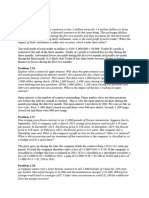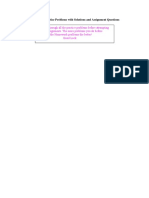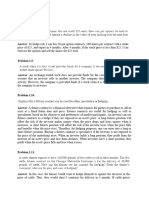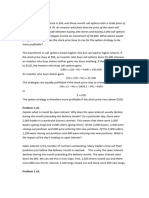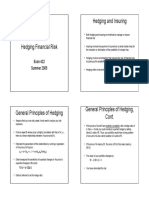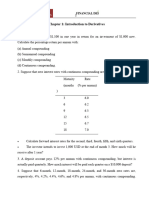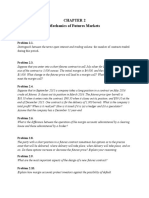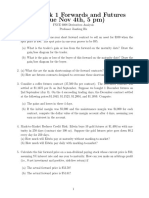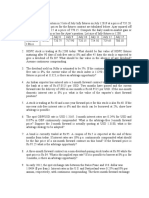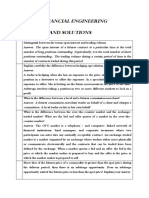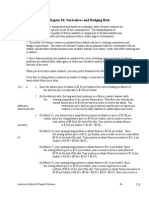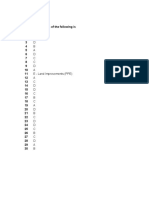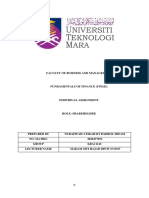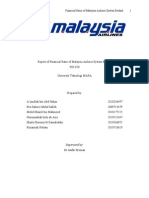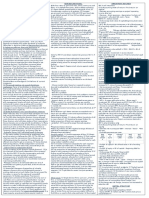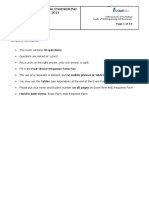ESSEC BBA
Finance 2
Part 4
Problem Set
FORWARDS AND FUTURES
The following problems are taken from the book ‘Options, Futures, and Other Derivatives,
8th Edition’ by John C. Hull. Some problems have been modified for the purpose of this
course.
Problem 1.1.
What is the difference between a long forward position and a short forward position?
Solution:
When a trader enters into a long forward contract, she is agreeing to buy the underlying asset for
a certain price at a certain time in the future. When a trader enters into a short forward contract,
she is agreeing to sell the underlying asset for a certain price at a certain time in the future.
Problem 1.6.
A trader enters into a short cotton futures contract when the futures price is 50 cents per pound.
The contract is for the delivery of 50,000 pounds. How much does the trader gain or lose if the
cotton price at the end of the contract is (a) 48.20 cents per pound; (b) 51.30 cents per pound?
Solution:
(a) The trader sells for 50 cents per pound something that is worth 48.20 cents per pound. Gain
¿($ 0.5000−$ 0.4820)× 50,000=$ 900 .
(b) The trader sells for 50 cents per pound something that is worth 51.30 cents per pound. Loss
¿($ 0.5130−$ 0.5000)× 50,000=$ 650 .
Problem 2.3.
Suppose that you enter into a short futures contract to sell July silver for $17.20 per ounce. The
size of the contract is 5,000 ounces. The initial margin is $4,000, and the maintenance margin is
$3,000. What change in the futures price will lead to a margin call? What happens if you do not
meet the margin call?
Solution:
There will be a margin call when $1,000 has been lost from the margin account. This will occur
when the price of silver increases by 1,000/5,000 ¿ $0.20. The price of silver must therefore rise
to $17.40 per ounce for there to be a margin call. If the margin call is not met, your broker closes
out your position.
Problem 2.4.
Suppose that in September 2015 a company takes a long position in a contract on May 2016
crude oil futures. It closes out its position in March 2016. The futures price (per barrel) is $88.30
1
�when it enters into the contract, $90.50 when it closes out its position, and $89.10 at the end of
December 2015. One contract is for the delivery of 1,000 barrels. What is the company’s total
profit? When is it realized?
Solution:
The total profit is ($90.50 −¿ $88.30) × 1,000 ¿ $2,200. Of this ($89.10 −¿ $88.30) × 1,000 or
$800 is realized on a day-by-day basis between September 2015 and December 31, 2015. A
further ($90.50 −¿ $89.10) × 1,000 or $1,400 is realized on a day-by-day basis between
January 1, 2016, and March 2016.
Problem 2.10.
Explain how margin accounts protect investors against the possibility of default.
Solution:
A margin is a sum of money deposited by an investor with his or her broker. It acts as a
guarantee that the investor can cover any losses on the futures contract. The balance in the
margin account is adjusted daily to reflect gains and losses on the futures contract. If losses are
above a certain level, the investor is required to deposit a further margin. This system makes it
unlikely that the investor will default. A similar system of margin accounts makes it unlikely that
the investor’s broker will default on the contract it has with the clearing house member and
unlikely that the clearing house member will default with the clearing house.
Problem 2.11.
A trader buys two July futures contracts on frozen orange juice. Each contract is for the delivery
of 15,000 pounds. The current futures price is 160 cents per pound, the initial margin is $6,000
per contract, and the maintenance margin is $4,500 per contract. What price change would lead
to a margin call? Under what circumstances could $2,000 be withdrawn from the margin
account?
Solution:
There is a margin call if more than $1,500 is lost on one contract. This happens if the futures
price of frozen orange juice falls by more than 10 cents to below 150 cents per pound.
$2,000 can be withdrawn from the margin account if there is a gain on one contract of $1,000.
This will happen if the futures price rises by 6.67 cents to 166.67 cents per pound.
Problem 2.24.
A cattle farmer expects to have 120,000 pounds of live cattle to sell in three months. The live-
cattle futures contract traded by the CME Group is for the delivery of 40,000 pounds of cattle.
How can the farmer use the contract for hedging? From the farmer’s viewpoint, what are the pros
and cons of hedging?
Solution:
The farmer can short 3 contracts that have 3 months to maturity. If the price of cattle falls, the
gain on the futures contract will offset the loss on the sale of the cattle. If the price of cattle rises,
2
�the gain on the sale of the cattle will be offset by the loss on the futures contract. Using futures
contracts to hedge has the advantage that the farmer can greatly reduce the uncertainty about the
price that will be received. Its disadvantage is that the farmer no longer gains from favorable
movements in cattle prices.
Problem 2.25.
It is July 2014. A mining company has just discovered a small deposit of gold. It will take six
months to construct the mine. The gold will then be extracted on a more or less continuous basis
for one year. Futures contracts on gold are available with delivery months every two months
from August 2014 to December 2015. Each contract is for the delivery of 100 ounces. Discuss
how the mining company might use futures markets for hedging.
Solution:
The mining company can estimate its production on a month by month basis. It can then short
futures contracts to lock in the price received for the gold. For example, if a total of 3,000 ounces
are expected to be produced in September 2015 and October 2015, the price received for this
production can be hedged by shorting 30 October 2015 contracts.
Problem 2.30.
A company enters into a short futures contract to sell 5,000 bushels of wheat for 750 cents per
bushel. The initial margin is $3,000 and the maintenance margin is $2,000. What price change
would lead to a margin call? Under what circumstances could $1,500 be withdrawn from the
margin account?
Solution:
There is a margin call if $1000 is lost on the contract. This will happen if the price of wheat
futures rises by 20 cents from 750 cents to 770 cents per bushel. $1500 can be withdrawn if the
futures price falls by 30 cents to 720 cents per bushel.
Problem 3.1.
Under what circumstances are (a) a short hedge and (b) a long hedge appropriate?
Solution:
A short hedge is appropriate when a company owns an asset and expects to sell that asset in the
future. It can also be used when the company does not currently own the asset but expects to do
so at some time in the future. A long hedge is appropriate when a company knows it will have to
purchase an asset in the future. It can also be used to offset the risk from an existing short
position.
Problem 5.2.
What is the difference between the forward price and the value of a forward contract?
Solution:
The forward price of an asset today is the price at which you would agree to buy or sell the asset
at a future time. The value of a forward contract is zero when you first enter into it. As time
3
�passes the underlying asset price changes and the value of the contract may become positive or
negative.
Problem 5.3.
Suppose that you enter into a two-year forward contract on a non-dividend-paying stock when
the stock price is $30 and the risk-free interest rate is 6% per annum. What is the forward price?
Solution:
The forward price is
2
30∗(1+6 %) =$ 33.71
Problem 5.9.
A two-year long forward contract on a non-dividend-paying stock is entered into when the stock
price is $40 and the risk-free rate of interest is 10% per annum.
(a) What are the forward price and the initial value of the forward contract?
(b) One year later, the price of the stock is $45 and the risk-free interest rate is still 10%. What is
the value of the forward contract?
Solution:
(a) The forward price, F 0, is:
2
F 0=40∗(1+10 %) =48.40
The initial value of the forward contract is zero.
(b) One year later: Forward price in the contract is still $48.40. The value of the contract, V 1,
after one year is:
1
V 1=45−48.40/(1+10 % )
¿ $ 1.00
Problem 5.15.
The spot price of silver is $25 per ounce. The storage costs are $0.42 per ounce per year payable
every year in advance. Assuming that interest rates are 5% per annum for all maturities, calculate
the futures price of silver for delivery in two years.
Solution:
The present value of the storage costs:
0.42 + 0.42/(1+5%) = $0.82
The futures price is:
2
F 0=( 25+0.82 )∗(1+5 % ) =$ 28.47
i.e., it is $28.47 per ounce.
4
�The following problems are taken from the book ‘Investment and Portfolio Management,
9th Edition, Chapter 20’ by Bodie, Kane, and Marcus. Some problems have been modified
for the purpose of this course.
Problem 13
Farmer Brown grows Number 1 red corn and would like to hedge the value of the coming
harvest. However, the futures contract is traded on the Number 2 yellow grade of corn. Suppose
that yellow corn typically sells for 80% of the price of red corn. If he grows 100,000 bushels, and
each futures contract calls for delivery of 5,000 bushels, how many contracts should Farmer
Brown buy or sell to hedge his position?
Solution:
The farmer must sell forward:
100,000 × (1/0.80) = 125,000 bushels of yellow corn
This requires selling: 125,000/5,000 = 25 contracts
Problem 18
If the spot price of gold is $1,500 per troy ounce, the risk-free interest rate is 2%, and storage and
insurance costs are zero, what should be the forward price of gold for delivery in 1 year?
Solution:
F0 = S0(l + rf )T = 1500 (1+.02)^1 = 1530
5
�OPTIONS
Problem 1
Explain carefully the difference between selling a call option and buying a put option.
Selling a call option involves giving someone else the right to buy an asset from you. It gives
you a payoff of –(ST - K) if ST > K, and 0 if ST < K.
Buying a put option involves buying an option from someone else. It gives a payoff of (K - ST) if
ST < K, and 0 if ST > K.
When you sell a call option, the payoff is negative or zero. (This is because the counterparty
chooses whether to exercise.) When you buy a put option, the payoff is zero or positive. (This is
because you choose whether to exercise.)
Problem 2(a)
An investor buys a European call option with strike price of K and maturity T and sells a put with the
same strike price and maturity. Describe the investor’s position.
Payoff from long position in call option: 0 if ST < K, and (ST - K) if ST > K
Payoff from short position in put option: -(K - ST) if ST < K, and 0 if ST > K
Therefore, the payoff to the investor is:
0-(K - ST) if ST < K, and (ST - K)+0 if ST > K
(ST - K) if ST < K, and (ST - K) if ST > K
(ST - K) for all values of ST
This is ST −K in all circumstances.
Note: This is same as the payoff of long position in a forward contract.
Problem 2(b)
An investor sells a European call option with strike price of K and maturity T and buys a put
with the same strike price and maturity. Describe the investor’s position.
Payoff from short position in call option: 0 if ST < K, and -(ST - K) if ST > K
Payoff from long position in put option: (K - ST) if ST < K, and 0 if ST > K
Therefore, the payoff to the investor is:
0+(K - ST) if ST < K, and -(ST - K)+0 if ST > K
(K - ST) if ST < K, and (K - ST) if ST > K
(K - ST) for all values of ST
This is (K - ST) in all circumstances.
Note: This is same as the payoff of short position in a forward contract.
6
�Problem 5
A trader buys a call option with a strike price of $45 and a put option with a strike price of $40.
Both options have the same maturity. The call costs $3 and the put costs $4. Draw a diagram
showing the variation of the trader’s profit with the stock price.
Figure 1 shows the variation of the trader’s position with the asset price. We can divide the
alternative asset prices into three ranges:
a) When the asset price less than $40, the put option provides a payoff of 40−ST and the call
option provides no payoff. The options cost $7 and so the total profit is 33−S T .
b) When the asset price is between $40 and $45, neither option provides a payoff. There is a net
loss of $7.
c) When the asset price greater than $45, the call option provides a payoff of ST −45 and the put
option provides no payoff. Taking into account the $7 cost of the options, the total profit is
ST −52.
The trader makes a profit (ignoring the time value of money) if the stock price is less than $33 or
greater than $52. This type of trading strategy is known as a strangle.
Figure 1: Profit from trading strategy
Problem 6
A trader sells a six-month put option with a $25 strike price for $2.15 and buys a six-month put
option with a $29 strike price for $4.75. What is the initial investment? What is the total payoff
when the stock price in six months is (a) $23, (b) $28, and (c) $33.
The initial investment is $2.60. (a) $4, (b) $1, and (c) 0.
7
�Problem 7
[Bull spread] Suppose that call options on a stock with strike prices $20 and $25 cost $6 and $4,
respectively. A trader buys the $20 call and sells the $25 call. Construct a table that shows the payoff and
profit of the strategy.
Stock Price Payoff Profit
ST ≤ 20 0 -2
20 ≤ S T <25 ST −20 ST −22
ST ≥ 25 5 3
Problem 8
[Bear spread] Suppose that call options on a stock with strike prices $20 and $25 cost $6 and $4,
respectively. A trader sells the $20 call and buys the $25 call. Construct a table that shows the payoff and
profit of the strategy.
Stock Price Payoff Profit
ST ≤ 20 0 2
20 ≤ S T <25 20−S T 22−S T
ST ≥ 25 −5 −3
Problem 9
[Bull spread] Suppose that put options on a stock with strike prices $30 and $35 cost $4 and $7,
respectively. A trader buys the $30 put and sells the $35 put. Construct a table that shows the payoff and
profit of the strategy.
Stock Price Payoff Profit
ST < 30 −5 −2
30 ≤ S T <35 ST −35 ST −32
ST ≥ 35 0 3
Problem 10
[Bear spread] Suppose that put options on a stock with strike prices $30 and $35 cost $4 and $7,
respectively. A trader sells the $30 put and buys the $35 put. Construct a table that shows the payoff and
profit of the strategy.
Stock Price Payoff Profit
ST < 30 5 2
30 ≤ S T <35 35−S T 32−S T
ST ≥ 35 0 −3
8
�9










